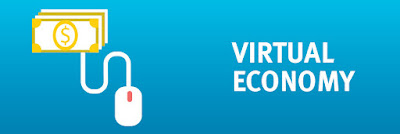WHAT IS VIRTUAL ECONOMY?|virtual economy|
In an announcement made to a congressional board of trustees on April 3, 2008, the Chairman of the Federal Reserve Bernanke said that "if Bear Stearns had been permitted to fizzle,
it would have prompted a "disorganized loosening up" of Bearn Stearns ventures held by people and other monetary establishments. Also, the unfriendly effect of a default would not have been bound to the money related framework but rather would have been felt extensively in the genuine economy through its impacts on resource values and credit in banking and insurance . In an article distributed by Newsweek, October 11, 2008, Daniel Gross composes : "in 2002, Apple's stock was exchanging far underneath the level of money on its books, crediting an estimation of zero to its brands and items, contrasted and a few billion at the stature of the blast". Both articulations allude to the presence of two perspectives of the economy: a genuine economy which is reflected by the level of money on corporate books, and a swelled, overstated perspective which is reflected in the present stock estimations of the business sector. The second perspective of the economy will be alluded to as a virtual economy in this article. Virtual economy, in this connection, varies from what is being called virtual economy business , where clients exchange a virtual nonexistent item with specific details and a fanciful quality. Be that as it may, this won't be the subject of this study.
it would have prompted a "disorganized loosening up" of Bearn Stearns ventures held by people and other monetary establishments. Also, the unfriendly effect of a default would not have been bound to the money related framework but rather would have been felt extensively in the genuine economy through its impacts on resource values and credit in banking and insurance . In an article distributed by Newsweek, October 11, 2008, Daniel Gross composes : "in 2002, Apple's stock was exchanging far underneath the level of money on its books, crediting an estimation of zero to its brands and items, contrasted and a few billion at the stature of the blast". Both articulations allude to the presence of two perspectives of the economy: a genuine economy which is reflected by the level of money on corporate books, and a swelled, overstated perspective which is reflected in the present stock estimations of the business sector. The second perspective of the economy will be alluded to as a virtual economy in this article. Virtual economy, in this connection, varies from what is being called virtual economy business , where clients exchange a virtual nonexistent item with specific details and a fanciful quality. Be that as it may, this won't be the subject of this study.
The second kind of virtual economy (VE) is the one that is imperative and is firmly identified with the disappointment of the budgetary entrepreneur framework as is being seen today. VE permits the economy to seem much bigger than its genuine size. This economy depends on the presumption that the genuine cash won't be taken advantage of and along these lines, it is conceivable to manage an accepted bigger (virtual) esteem for the cash. A decent case of this situation is the situation with Donald Trump. He ran ventures worth billions of dollars, while being more than 50 million dollars in the red. He was going to petition for individual chapter 11 in 1989 when he was squeezed to pay some of his obligations.
A parallel idea to virtual economy exists in PC frameworks, where the idea of virtual memory is utilized. Virtual memory is an extraordinary kind of association which permits the memory in the framework to seem much bigger than the genuine size of the memory. With this kind of association, it is conceivable to execute program applications which require much bigger memory than the framework really has. Virtual memory association in PC frameworks remains a keen method for running applications. In any case, there are a few situations where an application may break the points of confinement of virtual memory and cause the framework to whip, i.e. to fall flat. This happens when an application demands utilizing more than the extent of genuine memory quickly, at one given time.

